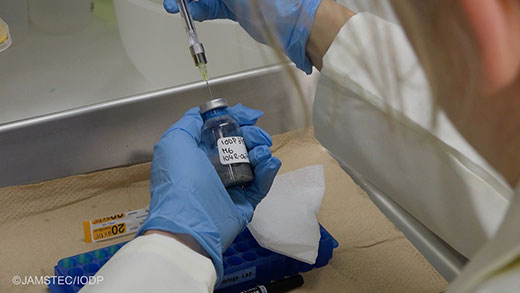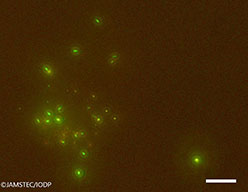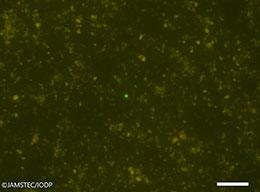
During IODP Expedition 370 T-Limit, the drilling vessel Chikyu recovered high-quality sediment core samples from the Nankai Trough subduction zone off Cape Muroto, Japan, down to the sediment-basement interface at 1,180 m below seafloor.
In this sediment column heated up to 120ºC at the bottom, the metabolic activity of small microbial communities was measured by radiotracer experiments, revealing that thermophilic-to-hyperthermophilic microbial communities in the deep, hot sediment near the upper temperature limit for life subsist with high cell-specific rates of energy metabolism.
These findings are published in Nature Communications.
Title:Rapid metabolism fosters microbial survival in the deep, hot, subseafloor biosphere
EurekAlert! : New research discovers surprising activity among organisms thriving in extremely deep, hot subseafloor

These findings are published in Nature Communications.
Title:Rapid metabolism fosters microbial survival in the deep, hot, subseafloor biosphere
- doi:
- 10.1038/s41467-021-27802-7
- Authors:
- Felix Beulig1, Florian Schubert2, Rishi R. Adhikari3, Clemens Glombitza4, Verena B. Heuer3, Kai-Uwe Hinrichs3, Kira L. Homola5, Fumio Inagaki6, Bo Barker Jørgensen1, Jens Kallmeyer2, Sebastian J. E. Krause7, Yuki Morono6, Justine Sauvage5,8, Arthur J. Spivack5, Tina Treude7
- Affiliations:
- 1. Aarhus University (Denmark), 2. German Research Centre for Geosciences (Germany), 3. University of Bremen (Germany), 4. Swiss Federal Institute of Technology Zurich (Switzerland), 5. University of Road Island (USA), 6. Japanese Agency for Marine-Earth Science and Technology, 7. University of California, Los Angeles (UCLA, USA), 8. University of Gothenburg (Sweden)
EurekAlert! : New research discovers surprising activity among organisms thriving in extremely deep, hot subseafloor


- Scientific ocean drilling had successfully penetrated around the source regions of slow earthquakes in the Nankai Trough off Cape Muroto.
- A high-pressure aquifer with a lateral extent of hundreds of meters was first confirmed along the shallow plate boundary, which was adjacent to the areas where slow earthquakes have occurred.
- Slow earthquakes may be caused by relatively small, scattered, high-pressurized subsurface aquifers, such as the one discovered by us.
Title:High Fluid-Pressure Patches beneath the Décollement: A Potential Source of Slow Earthquakes in the Nankai Trough off Cape Muroto
- URL:
- DOI:10.1029/2021JB021831
- Authors:
- Takehiro Hirose1, Yohei Hamada1, Wataru Tanikawa1, Nana Kamiya2, Yuzuru Yamamoto3, Takeshi Tsuji4, Masataka Kinoshita5, Verena. B. Heuer6, Fumio Inagaki1, Yuki Morono1, and Yusuke Kubo1
- 1. Japan Agency for Marine-Earth Science and Technology (JAMSTEC)
2. Graduate School of Engineering, Kyoto University
3. Graduate School of Science, Kobe University
4. Graduate School of Engineering, Kyusyu University
5. Earthquake Research Institute, The University of Tokyo
6. Center for Marine Environmental Sciences, University of Bremen


At what depth beneath the seabed does it become so hot that microbial life is no longer possible? International Ocean Discovery Program(IODP) Expedition 370 (T-Limit) at the Nankai Trough subduction zone, which was explored by the drilling vessel Chikyu in 2016, has provided new insights into the temperature limits of life beneath the ocean floor.
These findings are published in the professional journal Science.
Title:Temperature limits to deep subseafloor life in the Nankai Trough subduction zone



Press release by the university of Bremen
These findings are published in the professional journal Science.
Title:Temperature limits to deep subseafloor life in the Nankai Trough subduction zone
- doi:
- 10.1126/science.abd7934
- Authors:
- Verena B. Heuer, Fumio Inagaki, Yuki Morono, Yusuke Kubo, Arthur J. Spivack, Bernhard Viehweger, Tina Treude, Felix Beulig, Florence Schubotz, Satoshi Tonai, Stephen A. Bowden, Margaret Cramm, Susann Henkel, Takehiro Hirose, Kira Homola, Tatsuhiko Hoshino, Akira Ijiri, Hiroyuki Imachi, Nana Kamiya, Masanori Kaneko, Lorenzo Lagostina, Hayley Manners, Harry‐Luke McClelland, Kyle Metcalfe, Natsumi Okutsu, Donald Pan, Maija J. Raudsepp, Justine Sauvage, Man‐Yin Tsang, David T. Wang, Emily Whitaker, Yuzuru Yamamoto, Kiho Yang, Lena Maeda, Rishi R. Adhikari, Clemens Glombitza, Yohei Hamada, Jens Kallmeyer, Jenny Wendt, Lars Wörmer, Yasuhiro Yamada, Masataka Kinoshita, Kai‐Uwe Hinrichs


Fluorescence micrograph of deep subseafloor microbial cells detected at Site C0023. The cells were stained with a green fluorescent dye SYBR Green I.
Left: Microbial cells separated from a sediment core sample (43R-3) at the depth of 652.0 m at 76 °C.
Right: A microbial cell detected from a sediment core sample (112R-2) at the depth of 1176.8 m at 120°C (one cell in the center of the picture). Scale indicates 20 micrometers (1/50 of a millimeter). Credit: JAMSTEC/IODP

Press release by the university of Bremen

















